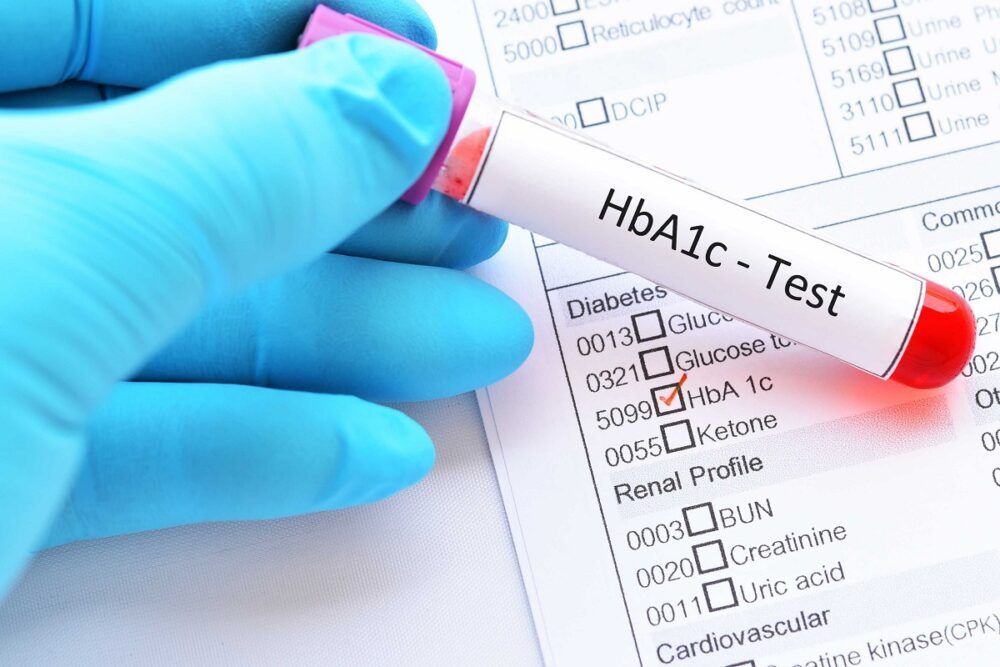HbA1C test is a blood test that evaluates a person’s average blood sugar levels over the last 3 months. Doctors make use of this test to check for type 1 diabetes, type 2 diabetes, and prediabetes. This test also aids in proper sugar monitoring in diabetic patients. Keeping the A1C levels within normal or target range reduces the risk of developing diabetes or its complications. Read further to learn what A1C test results imply.
What is an A1C chart?
The HbA1c test chart helps a person convert and know their A1C test results. A doctor provides more context and explains ways to keep blood sugar levels within limits.
|
|
A1C PERCENTAGE |
ESTIMATED AVERAGE GLUCOSE (EAG) |
|
|
NORMAL |
<5.7% |
<117 mg/dl |
6.5 mmol/l |
|
PRE-DIABETIC |
5.7-6.4% |
117-137 mg/dl |
6.5-7.6 mmol/l |
|
DIABETIC |
>6.4% |
>137 mg/dl |
>7.6 mmol/l |
|
|
6.5% |
140 mg/dl |
7.8 mmol/l |
|
|
7.0% |
154 mg/dl |
8.6 mmol/l |
|
|
7.5% |
169 mg/dl |
9.4 mmol/l |
|
|
8.0% |
183 mg/dl |
10.1 mmol/l |
|
|
8.5% |
197 mg/dl |
10.9 mmol/l |
|
|
9.0% |
212 mg/dl |
11.8 mmol/l |
|
|
9.5% |
226 mg/dl |
12.6 mmol/l |
|
|
10.0% |
240 mg/dl |
13.4 mmol/l |
How the A1C test works?
The A1C test is also known as the:
- hemoglobin A1C, or HbA1c, test
- glycohemoglobin test
- glycated hemoglobin test
The A1C test evaluates the percentage of RBCs that have glucose-coated hemoglobin. This evaluation provides doctors an idea of the individual’s average blood sugar levels over the past 2-3 months. Undergoing the A1C test is straightforward. A healthcare expert takes a blood sample and sends it for testing.
A healthcare provider might order this test to:
- diagnose prediabetes
- diagnose type 1 or type 2 diabetes
- monitor the blood sugar levels of a diabetic patient to check how well their treatment is functioning.
If an individual uses insulin to manage diabetes, their physician can also ask them to monitor their blood sugar levels at home using a blood glucose meter or continuous glucose monitor. In this case, the individual is still required to undergo regular A1C testing. Check this If you are looking for the best glucometer in India.
Normal levels
A1C levels are measured in terms of percentage. Alternately, they might report as:
- estimated average glucose (eAG)
- milligrams per deciliter (mg/dL)
- millimoles per liter (mmol/L).
Blood glucose meters and continuous glucose monitors also offer eAG readings. The A1C test offers a more precise long-term average. It takes into account variations during the day, such as overnight and after meals. A normal A1C level is under 5.7%. Normal eAG is under 117 mg/dL or 6.5 mmol/L. If somebody’s A1C levels are greater than normal, it might indicate diabetes or prediabetes. Their physician may order a repeat test to verify this.
Target levels in diabetic patients
A physician would set an individual’s target A1C level depending on many factors. The right target differs from individual to individual. For a person with diabetes, the target A1C level might depend on:
- the individual’s age
- their overall health
- their recommended treatment plan
- any history of adverse effects from the treatment. These may include episodes of low blood glucose or hypoglycemia
- whether they are pregnant
- any complications from diabetes
- the individual’s preferences and treatment priorities
- how long they have had diabetes
usually, a doctor may suggest aiming for A1C levels under 6.5% if an individual:
- is young and has a long life expectancy
- is efficiently managing their diabetes. This is possible with lifestyle changes or metformin alone.
- is otherwise in good health
- has had diabetes for a short period
A doctor may advise A1C targets of 7.0 to 8.5% if an individual:
- is older and has a shorter life expectancy
- has diabetes that is hard to manage, even with multiple medications
- has other chronic health conditions
- has a history of severe hypoglycemia or other adverse effects of treatment
- has experienced complications of diabetes
- has had diabetes for a longer period
When to see a doctor
An individual must make an appointment with their physician if they:
- think they may have diabetes complications
- have queries or concerns regarding their treatment plan
- have had signs of high or low blood sugar levels
- are finding it difficult to keep their blood sugar levels within the target range
Signs of high blood sugar levels may include:
- fatigue
- infrequent thirst
- frequent urination
- hazy vision
Signs of low blood glucose levels may include:
- hunger
- shaking
- sweating
- nervousness, irritation, or anxiety
- confusion
- dizziness
A1C test outcomes are generally a percentage. However, they may come as an eAG measurement. Target A1C levels differ from individual to individual. This may depend on age, overall health, and other factors. Having high A1C levels might show that the diabetic has a high risk of associated complications.








































